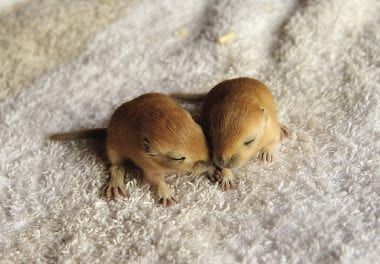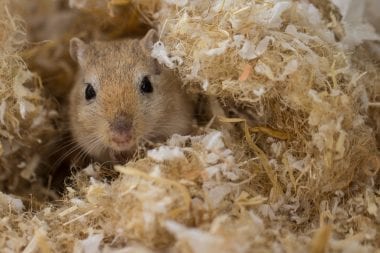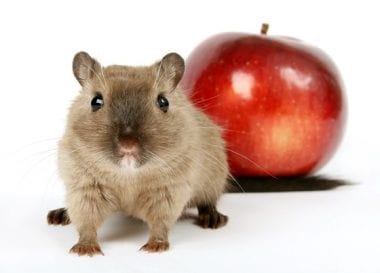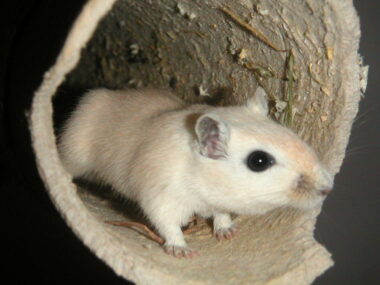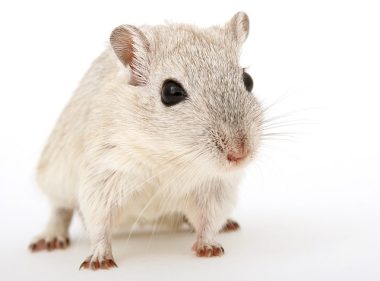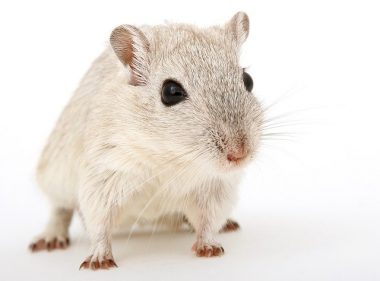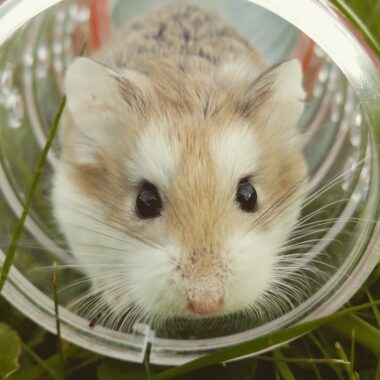
It is not unusual for pet owners to confuse a hamster with a gerbil. The reason is their similarity in looks and size. Both the species have genera that are quite distinct from each other, but all are not kept as pets.
It is very easy for the untrained eye to mistake a gerbil for a hamster. Both are rodents belonging to different subfamilies. From the hamster family, only about five genera are kept as house pets. The gerbil subfamily boasts of about 110 species out of which only two breeds are known to be kept as pets.
Species of Gerbils As Pets
The two species of gerbils that are kept as pets are the fat-tailed gerbil and the Mongolian gerbil.
Hamster Species That Are Kept As Pets
Below are the five species of hamsters that are kept as pets:
i. Roborovskii’s hamster.
ii. Chinese hamster.
iii. Campbell’s Russian Hamster.
iv. Winter White Hamster.
v. The Syrian or Golden Hamster.
The Tail Of Hamster Vs. Gerbil
The tails of gerbils are quite long, taking up almost half their body length. Depending upon the species, the tail can be furred or depilated. Of the two species, the fat-tailed rodent has a smooth and hairless tail. The Mongolian gerbil has a thin furred tail.
Hamsters have short tails in comparison with gerbils. Hamster tails do not grow beyond an inch. Chinese hamster is an exemption of this basic characteristic. They are distinguished by the length of their tails which is comparatively longer and can grow up to a length of one inch.
Activity Levels Of Hamsters And Gerbils
It is usual for hamsters to become depressed in captivity. It renders them inactive and moody giving an impression of lethargy. This doesn’t mean that hamsters do not move at all. They are more nocturnal and tend to sleep during day time and engage in activities after sundown.
Gerbils are highly active that sometimes the females attack the males. Their swift climbing calibers are phenomenal. The inherent burrowing nature provides for amusing moments. They sleep at night and are active during the day.
Facial And Bodily Features
Both are lovable, sweet creatures with distinct features.
Hamsters have wide and round faces compared to gerbils. They have plump cheeks exaggerated due to short snouts. Sometimes they look like a little bundle.
Gerbils have leaner bodies and faces which give them a leaner appearance. The sleek look gets them mistaken for rats.
The Limbs Of Hamster Vs. Gerbil
Gerbils and hamsters are in the habit of standing on their hind legs as most rodents do. A hamster doesn’t move around on its hind legs like a gerbil. The hind legs of a gerbil are heftier than the posterior of a hamster. Gerbils are great jumpers due to this feature.
Nipping Habits- Hamster Vs. Gerbil
Both the species have sharp and pointed teeth. The age between 18 and 35 days are very important in forming habits for a gerbil. A properly reared gerbil doesn’t nibble or bite humans.
Hamsters tend to munch on objects that have an appealing aroma. If a hamster feels fear or threat, it can bite.
Care- Hamster Vs. Gerbil
First the common factors:
i. Well aerated cages having sound foundations.
ii. Moisture absorbing bedding that allows burrowing.
iii. Toys for chewing.
iv. A good exercise wheel.
v. Water container.
The differences:
Space: Hamsters should get a minimum of 3 sq ft of deck area. Experts recommend aquariums covered with mesh tops to keep gerbils. An aquarium that can hold five gallons of water is sufficient to keep one gerbil.
Cleaning: A hamster’s nest needs to be cleaned every 4 to five weeks whereas a gerbil’s den should be washed every two weeks.

Food Habits
Both the species need an intake rich in seeds, greens, and fruits but the protein requirements are different for a hamster and a gerbil.
Gerbils: Commercial pet foods containing a grain and protein mix of 15% is what vets recommend. Many gerbil owners are known to include meal worms and crickets in their diet.
Hamsters: They like foods that contain eggs and chicken. Vet recommendation for protein varies from 18 to 23 depending on your hamster.
Longevity
Hamsters: The average lifespan of a hamster in captivity is two years.
Gerbils: They live up to three years which is one year more than hamsters.
There have been recorded cases of both the animals living for four years.
The difference in Behavioral Patterns
When you are in a tie over a hamster Vs. gerbil-situation at home, think about the personality traits of both the species.
Hamsters are nocturnal creatures. They are either sleeping or inactive during most of the daytime. According to pet specialists, the most suitable time to interact with a hamster is evenings and early mornings. Most hamster owners have experienced ill-temper from their pets whenever they were woken up prematurely. During their active hours, hamsters find time for building burrows divided into chambers to rest and to store food.
Golden hamster: They enjoy human touch for a short period before warding off, but crave for attention.
Dwarfs: Some of these species can recognize the voices of humans who interact with them and acknowledge it. They enjoy an environment that provides them with motivation to scout and move around.
Gerbils are neither diurnal nor nocturnal. They are adaptive to human behavior and easily calibrate with the patterns of the household. These active rodents that are fascinated by humans are also inquisitive and clever at the same time.
They like human touch and love getting petted by owners.
Color Differences
It is very difficult to set apart a gerbil from a hamster based on their colors alone. The coat colors of both the species are very similar. A closer inspection can reveal that there indeed exists a difference.
Hamsters: Unlike gerbils, their coats can have color patterns. Hamsters spot more colors too. The common colors attributed to the species include:
i. Brown.
ii. Orange.
iii. Black.
iv. White.
v. Grey.
vi. Reddish.
It is not uncommon to find hamsters that splosh a blend of the above colors.
Gerbils: They are not very colorful minions compared to hamsters. The common colors of gerbils are:
i. Black.
ii. White.
iii. Grey.
Due to the limitation of colors, they do not display patterns of colors.
Territorial Needs
Hamsters: Sometimes, hamsters exhibit intense territorial behavior. Adding another hamster to their habitat can distress them. They cannot cohabit in groups. Some hamsters from the dwarf species fight among themselves if kept together. Golden hamsters need to be left alone and cannot appreciate the company of another hamster.
Despite their territorial demands, they insist on attention from their owners.
Gerbils: Unlike hamsters they need company. Seclusion does not go well for gerbils because it makes them depressed. Experienced hamster owners recommend that they be kept in pairs.
Climatic Conditions
Gerbils: Vets suggest keeping gerbils in aquarium cages to prevent them from getting dehydrated. They cannot sustain in higher temperatures as their natural habitats are cool. It is easy to control the temperature of enclosures designed like aquariums. The temperature of such cages can be maintained between 680 F and 770 F to suit the occupants.
Hamsters: Hamsters are accustomed to desert conditions. If you arrange for your hamster to live in a temperature below 650 F, they can freeze or catch a cold which may escalate into pneumonia. Hamsters in captivity are known to enter a state called false hibernation in cold rooms.
General Health
There are certain ailments peculiar to both the species although they are known to be comparatively healthy pets. Pet owners should have first-hand information regarding their constitution to understand health issues better.
Hamsters: Their teeth never stop growing even in old age. This makes hamsters prone to dental illnesses. Hamsters that live in their natural habitat spend a lot of time chewing which keeps their teeth filed. Providing them with toys that are meant for chewing is a good option to keep their teeth naturally snipped.
A bacterial infection called proliferative ileitis (wet tail disease) can be fatal to house hamsters. It is diarrhea found in the species that needs immediate attention. The glands of hamsters are vulnerable to tumors that can quite often turn malignant. Timely medical attention takes care of such tumors.
Gerbils: A common health issue faced by most gerbils is skin conditions. They typically belong to one of three categories:
i. Aural cholesteatoma. This is an obstructive ear condition caused by ear masses. As the lump grows the gerbil tilts its head to one side giving the ailment another name- head tilt disease.
ii. Vets suggest that 40% of gerbils are susceptible to seizures and most of the cases are inherited.
iii. Tail de-gloving from loss of skin or fur.
Smell From Body Wastes
Gerbils: Their natural habitats are deserts. Desert animals bring out less waste in comparison with species living in normal climatic conditions.
Hamsters: They are not from desert lands and produce more body wastes than gerbils. This means that their enclosures require to be cleaned more often than that of a gerbil’s.

